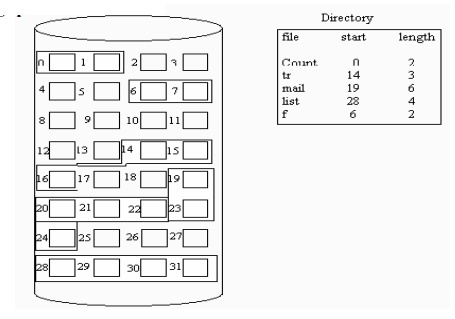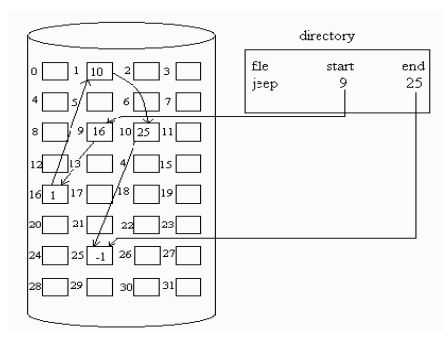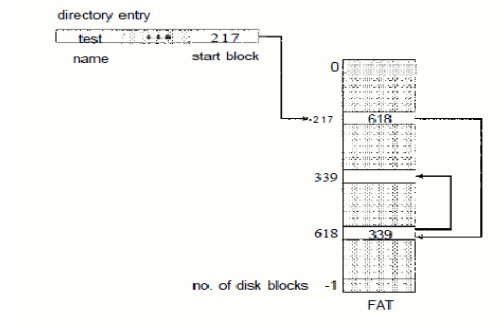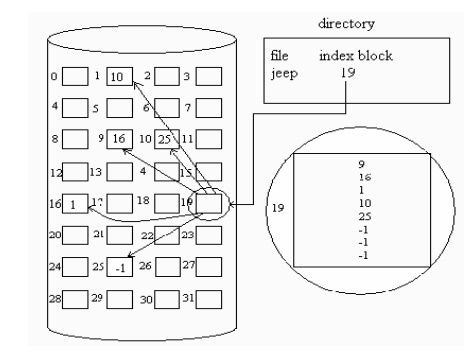Chapter: Operating Systems : File Systems
Allocation Methods
ALLOCATION
METHODS
The main
problem is how to allocate space to these files so that disk space is utilized
effectively and files can be accessed quickly .
There are
there major methods of allocating disk space:
1. Contiguous
Allocation
2. Linked
Allocation
3. Indexed
Allocation
1. Contiguous Allocation
ü The
contiguous – allocation method requires each file to occupy a set of contiguous blocks on the disk.
ü Contiguous
allocation of a file is defined by the disk address and length (in block units) of the first block. If the file is n blocks long and starts at
location b, then it occupies blocks b,. b+1, b+2,….,b+n-1.
ü The
directory entry for each file indicates the address of the starting block and
the length of the area allocated for this file.
Disadvantages:
1. Finding space for a new file.

v The
contiguous disk space-allocation problem suffer from the problem of external
fragmentation. As file are allocated and deleted, the free disk space is broken
into chunks. It becomes a problem when the largest contiguous chunk is
insufficient for a request; storage is fragmented into a number of holes, no
one of which is large enough to store the data.
2 Determining how much space is
needed for a file.
When
the file is created, the total amount of space it will need must be found an
allocated how does the creator know the size of the file to be created?
If we
allocate too little
space to a
file, we may find
that file cannot be extended.
The
other possibility is to find a larger hole, copy the contents of the file to
the new space, and
release the previous
space. This series
of actions may be repeated as long as space exists, although it can be
time –consuming. However, in
this case, the user never needs
to be informed explicitly about
what is happening ;
the system continues despite the problem, although more and more
slowly.
Even
if the total amount of space needed for a file is known in advance
pre-allocation may be inefficient.
A
file that grows slowly
over a long
period (months or
years) must be allocated enough
space for its final
size, even though much of
that space may be unused for a long time the file, therefore has a large amount of internal fragmentation.
To overcome these disadvantages:
Use a
modified contiguous allocation scheme, in which a contiguous chunk of space
called as an extent is allocated initially and then, when that amount is not
large enough another chunk of contiguous space an extent is added to the
initial allocation.
Internal fragmentation can still be a problem if the extents are too large, and
external fragmentation can be a problem as extents of varying sizes are
allocated and deallocated.
2.
Linked Allocation
Linked allocation solves all problems of contiguous allocation.
With
linked allocation, each file is a linked list of disk blocks, the disk
blocksmay be scattered any where on the disk.
The
directory contains a pointer to the first and last blocks of the file. For
example, a file of five blocks might start at block 9, continue at block 16,
then block 1, block 10, and finally bock 25.
Each
block contains a pointer to the next block. These pointers are not made
available to the user.
There
is no external fragmentation with linked allocation, and any free block on the
free space list can be used to satisfy a request.
The
size of a file does not need to the declared when that file is created. A file
can continue to grow as long as free blocks are available consequently, it is
never necessary to compacts disk space.

Disadvantages:
1.
Used effectively only for sequential access
files.
· To find the ith block of
a file, we must start at the beginning of that file, and follow the pointers
until we get to the ith block. Each aces to a pointer requires a disk read, and
sometimes a disk seek consequently, it is inefficient to support a direct-
access capability for linked allocation files.
2. Space
required for the pointers
· If a
pointer requires 4 bytes out of a 512-byte block, then 0.78 percent of the disk
is being used for pointers, rather than for information.
·
Solution to this problem is to collect blocks into
multiples, called clusters, and to
allocate the clusters rather than blocks. For instance, the
file system may define a clusters as 4 blocks, and operate on the disk in only
cluster units.
3. Reliability
•Since the files are linked
together by pointers scattered all over the disk hardware failure might result
in picking up the wrong pointer. This error could result in linking into the
free- space list or into another file. Partial solution are to use doubly
linked lists or to store the file names in a relative block number in each
block; however, these schemes require even more over head for each file.
File Allocation Table (FAT)
ü An
important variation on the linked allocation method is the use of a file
allocation table(FAT).
ü This
simple but efficient method of disk- space allocation is used by the MS-DOS and
OS/2 operating systems.
ü A section
of disk at beginning of each partition is set aside to contain the table.
ü The table
has entry for each disk block, and is indexed by block number.
ü The FAT
is much as is a linked list.
ü The
directory entry contains the block number the first block of the file.
ü The table
entry indexed by that block number contains the block number of the next block
in the file.
ü This
chain continues until the last block which has a special end – of – file
value as the table entry.
ü Unused
blocks are indicated by a 0 table value.
ü Allocating
a new block file is a simple matter of finding the first 0 – valued
table entry, and replacing the previous end of file value with the address of
the new block.
ü The 0 is
replaced with the end – of – file
value, an illustrative example is the FAT structure for a file consisting of
disk blocks 217,618, and 339.

3. Indexed
Allocation
v Linked allocation
solves the external – fragmentation and size-
declaration problems of contiguous allocation.
v Linked
allocation cannot support efficient direct access, since the pointers to the
blocks are scattered with the blocks themselves all over the disk and need to
be retrieved in order.
v Indexed
allocation solves this problem by bringing all the pointers together into one
location: the index block.
ü Each file has its own index
block, which is an
array of disk – block addresses.
ü The ith
entry in the index block points to the ith block of the file.
ü The
directory contains the address of the index block .
ü To read
the ith block, we use the pointer in the ith index – block
entry to find and read the desired block this scheme is similar to the paging
scheme .
ü When the
file is created, all pointers in the pointers in the index block are set to
nil. when the ith block is first written, a block is obtained from the free
space manager, and its address is put in
the ith index – block entry.
ü Indexed
allocation supports direct access, without suffering from external
fragmentation , because any free block on the disk may satisfy a request for
more space.

Disadvantages
1.Pointer
Overhead
Indexed allocation does suffer from wasted space.
The pointer over head of the index block is generally greater than the pointer
over head of linked allocation.
2.
Size of Index block
If the index block is too small, however, it will
not be able to hold enough pointers for a large file, and a mechanism will have
to be available to deal with this issue:
Linked
Scheme: An index block is normally one disk block. Thus, it
can be read and written directly by itself. To allow for large files, we may
link together several index blocks.
Multilevel index: A variant
of the linked representation is to use a first level index block to point
to a set of second – level index blocks.
Combined scheme:
o Another alternative, used in the
UFS, is to keep the first, say, 15 pointers of the index block in the file’s inode.
§
The first 12 of these pointers point to direct
blocks; that is for small ( no more than 12 blocks) files do not need a
separate index block
o The next pointer is the address of a single indirect
block.
ü
The single indirect block is an index block,
containing not data, but rather the addresses of blocks that do contain data.
o Then there is a double indirect
block pointer, which contains the address of a block that contain pointers to
the actual data blocks. The last pointer would contain pointers to the actual
data blocks.
o
The last pointer would contain the address of a
triple indirect block.
Related Topics